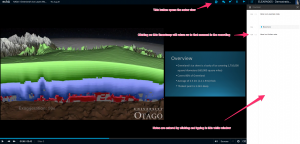The new Otago Capture system will bring students the ability to make notes and annotations within the same system they use to view the lecture recordings.
Obviously, it has always been possible for students to take notes on their lectures. The advantage of the new note taking tools in Otago Capture is that they link these notes in a very direct and straightforward way to the course content they pertain to.
Each annotation is taken alongside a moment in the recording, and a timestamp for that moment is created alongside the note. When a student revisits her notes later, she can click on the accompanying timestamp for a given annotation, to go back to the precise moment in the recording that gave rise to her comment.
If no particular comment is required, the system also allows for users to create bookmarks, which highlight key segments for later revisiting. Both comments and bookmarks are illustrated in the screenshot below.
These notes and annotations are easily collated and accessed from the Study Guide tab. Within this tab, a student can view her notes for any given lecture.
Student notes are private and can only be viewed by the student who took them. However, for analytics purposes, Course Co-ordinators will be able to see the number of words of notes a given student has taken (while not being able to access the content of those notes).
Since the entire point of this system is to group student notes alongside course content, these tools function best when used onscreen, within the Otago Capture application. However, if a hard copy or archival format is required, it is also possible for students to export their notes and bookmarks in a .txt format. This exported format does not include the course content, but does include all the work that the student has created, along with written (non-clickable) timestamps to provide the context.


